Sintra-Portugal.com
The best independent guide to Sintra
Sintra-Portugal.com
The best independent guide to Sintra
Quinta da Regaleira, Sintra – an independent tourism guide for 2025
Sintra is home to many extravagant 19th-century villas, but none are more intriguing than the Quinta da Regaleira.
This grand house is a fusion of eccentric, neo-gothic architecture and whimsically decorative features. However, the main attraction of Quinta da Regaleira is its gardens. These are not the conservative gardens of a conventional stately home, but those of an owner fascinated with secret religious orders and mysticism.
It is speculated that the owner used the grounds for secretive ceremonies and was a member of the Knights Templar. Found within the gardens is a hidden cave network and forested pathways that connect the ornamental lakes, chapel and - the highlight of Quinta da Regaleira - the Poço Iniciático (The Initiation Well).
The Quinta da Regaleira is a fascinating tourist attraction, and for many visitors to Sintra it is the highlight of the region. Unfortunately, its fame means it can get very crowded at peak times (which can be easily avoided) and many visitors are left confused when trying to travel to it.
This article will provide an independent guide to the wondrous Quinta da Regaleira and help you get the most from your visit here.
Related articles: Sintra introduction – Day trip to Sintra
Highlights of the Quinta da Regaleira
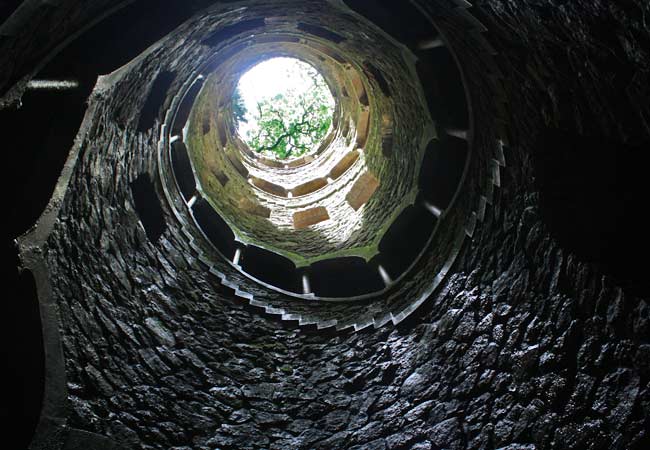
The Poço Iniciático (Initiation Well) – A mysterious, inverted tower constructed around a well, which descends via a spiral staircase to a Knights Templar Cross inscribed on the floor. Its design was inspired by secretive religious ceremonies, but possibly also hosted them!
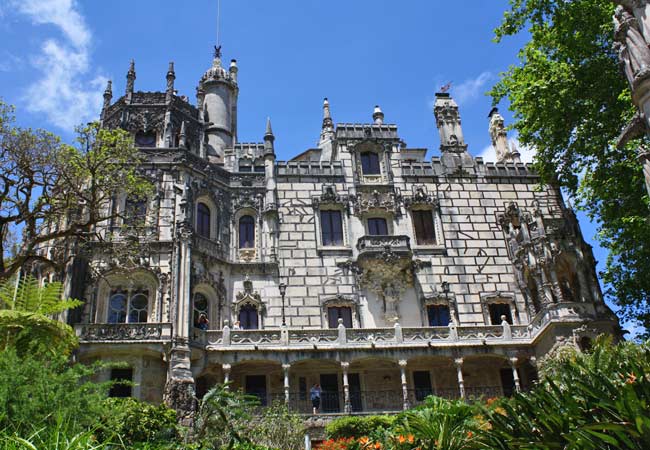
The Palácio da Regaleira - The luxurious villa with its flamboyant, neo-gothic exterior, including elaborate carvings and stone gargoyles.
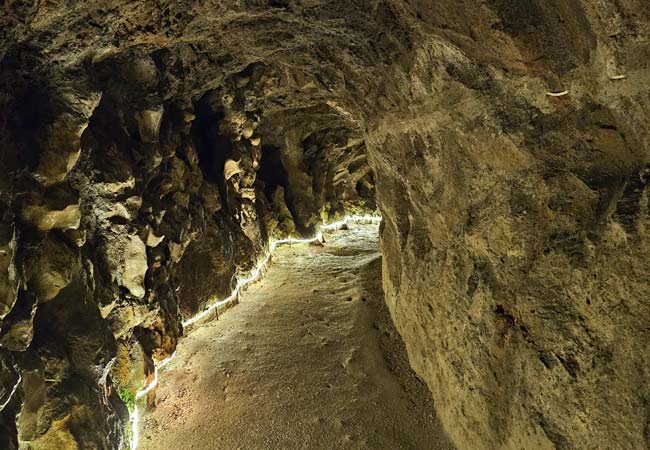
The Percursos subterrâneos - Designed to resemble a cave network, this series of hidden passageways dug beneath the gardens connects the Poço Iniciático to the Lago da Cascata.
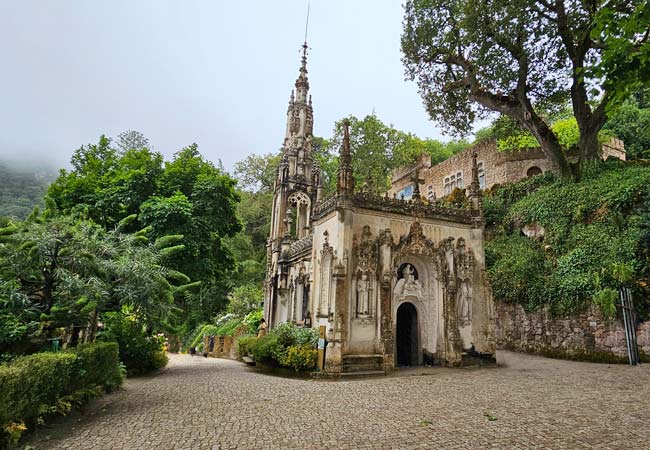
Capela da Santíssima Trindade – An ornate chapel with an impressive, gothic-styled tower, an interior that features Knights Templar icons, and a secret passageway leading from the crypt to the Palácio da Regaleira.
Tips for getting from the Quinta da Regaleira
1) Visit early or late in the day, and try to avoid the peak hours of 10.30am to 12pm and 1pm to 3pm.
2) Tickets are sold with timed entry in 30-minute blocks to control visitor numbers and provide a better experience. Tickets with the audio guide can be purchased from GetYourGuide website – [Tickets here]
3) While the Poço Iniciático is impressive, there can be long queues to walk down it. An alternative is the Poço Imperfeito (Unfinished Well), which is always less busy and more atmospheric.
4) The Quinta da Regaleira is easy to walk to from the historic centre of Sintra, so there is no need for a taxi, bus or expensive tuk-tuk. It is also faster to walk the 1.8km distance from the train station to the Quinta da Regaleira (route here) than taking the 435 bus service, due to the lengthy route the bus is forced to take.
5) The main entrance is hidden away on the far western side of the Quinta da Regaleira estate. To reach it, you need to walk around the entire southern and western exterior walls and follow the narrow roads.
6) Quinta da Regaleira opens at 10am. If possible, be there at opening time and go straight to the Poço Iniciático.
7) If the Quinta da Regaleira is too busy, do consider visiting the Palácio Biester, which is next door, or the Palácio de Monserrate, an underrated gem of Sintra (and our personal favourite place to visit during the peak season).
8) The Torre da Regaleira provides the best viewpoint of the entire gardens.
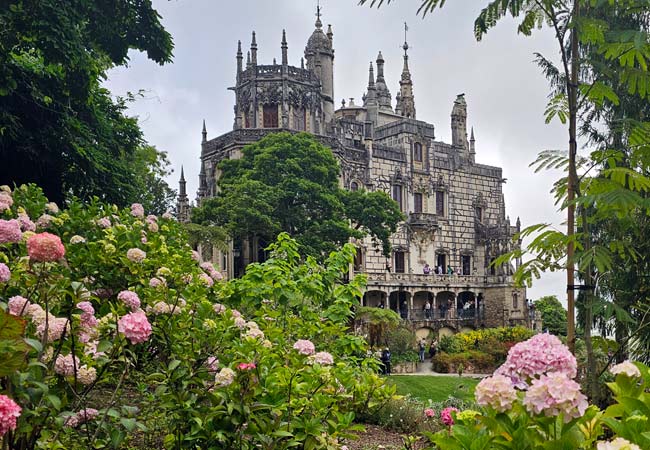
Tourist Information for the Quinta da Regaleira
The entrance fee for the Quinta da Regaleira is €15 for adults, €10 for youths (aged 6 to 17) and €10 for seniors.
The opening hours are from 10am to 7pm (summer) and 10am to 6.30pm (winter), with the last admission at 5.30pm year-round.
The Quinta da Regaleira moved to a time-based ticketing system in 2024 to limit visitor numbers and provide a better experience. This system eliminated the extremely long queues, which once took 90 minutes to gain entry. If you plan to visit the Quinta da Regaleira, always pre-book tickets, as otherwise you will be subject to availability and forced to waste much of the day standing in a queue. Tickets with the audio guide can be purchased from the GetYourGuide website – [Tickets here].
These tickets imply a "skip the queue" ticket, which they are not. You simply join the other 150 people who are entering at that timed entry and "skip" waiting in the general admission line. The audio guide is also highly recommended to provide a deeper insight into the complex.
Tickets without the audio guide can be purchased from the official website https://www.regaleira.pt/ (but note this will take payment in Euros).
Insight: We cannot emphasise how important it is to pre-buy tickets during peak season or when cruise ships are moored in Lisbon, as guided tours and coach parties block-book time slots.
If there are long queues buy tickets or time slots have gone, consider visiting Palácio de Monserrate or Palácio Biester instead. You can return to Quinta da Regaleira later in the day, preferably after 4pm when the crowds tend to diminish.
Insight: The Quinta da Regaleira is not owned by Parques De Sintra, the organisation that manages all of the other sights in Sintra.
A typical visit to the Quinta da Regaleira lasts 2 hours, and the majority of the time will be spent in the gardens. As this is an outdoor-focused attraction, do not visit on a wet day.
On-site is the Café da Regaleira, which gets mixed reviews, mainly due to it being extremely busy as it is the only location in the Quinta da Regaleira for food or drinks. Our advice is to bring your own water and have lunch in the historic centre.
Our opinion of the Quinta da Regaleira
The Quinta da Regaleira is a fascinating tourist attraction and a visit should definitely be included during your trip to Sintra.
In our opinion, it is the second-best attraction of Sintra - 1st Palácio da Pena, 2nd Quinta da Regaleira, 3rd Palácio de Monserrate, 4th Castelo dos Mouros, 5th Palácio Nacional and 6th Palácio Biester.
Our high regard for the Quinta da Regaleira is due to the variety of things to see here, with a plethora of sights to explore. This is the ideal attraction for those who may find historic buildings monotonous or have little interest in history.
The only downside, as with everything in Sintra, is that it can get very crowded with tourists. In the peak season, there will be countless people taking selfies at the viewpoints and long queues to enter the Poço Iniciático. Thankfully, the grounds are large enough for some tranquillity, especially to the rear around the Gruta da Virgem.
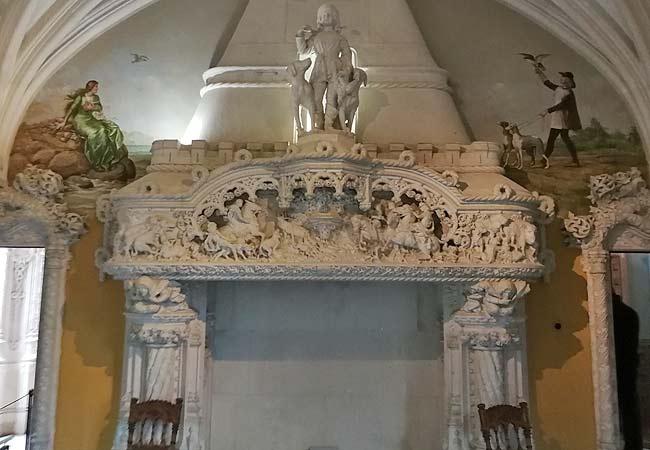
The Sala da Caça (the hunting room), is the grandest room of the house and was used as the dining room. The room’s art has the theme of the circle of life and is dominated by the huge fireplace.
Travel to the Quinta da Regaleira
The Quinta da Regaleira lies to the western side of Sintra and sits on the Rua Barbosa du Bocage. The main entrance is on the western side of the estate and is located at GPS 38.79585, -9.39724. From the Praça da República in central Sintra, it is 800 meters - a 10-minute walk.
From the train station, it is a 20-minute (1.8km) walk. This is a scenic route that passes around the Volta do Duche valley and through the historic centre of Sintra. The route is almost entirely flat and can be seen here on google maps.
The 435 bus service connects the train station to the Quinta da Regaleira and continues on to the Palácio de Monserrate. A single bus ticket costs €3.75, but often the 24-hour hop-on, hop-off ticket for all Sintra buses (at €12.50) will be encouraged for sale first. This ticket is useful if you plan to visit Palácio da Pena or Castelo dos Mouros on the same day as the Quinta da Regaleira.
The annoyance with the bus is the long and convoluted route it is forced to take, as the centre of Sintra is closed to all traffic. This involves a 4.4km journey on twisting roads and the bus often gets stuck in traffic along the N375. The bus route can be seen here.
Alternatives to the bus are taxis, TVDE cars (Uber or Bolt) or tuk-tuks. Uber and Bolt are significantly cheaper than taxis, but all types of traffic will be forced to go the same way as the bus.
Insight: If you only want to see the Quinta da Regaleira and the centre of Sintra, it is better to walk.
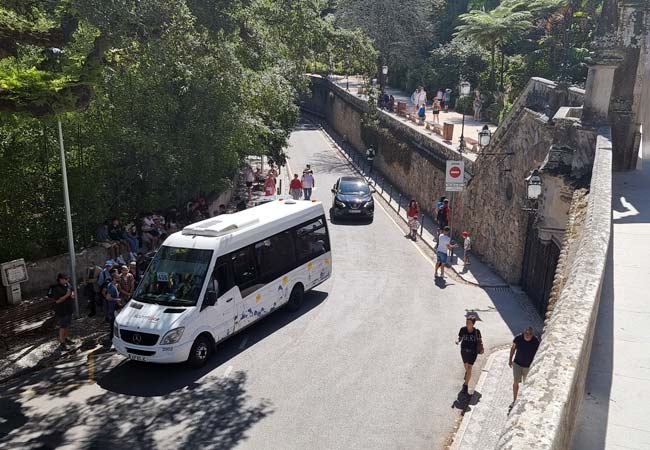
The small 435 bus at the Quinta da Regaleira bus stop. From here, it is an uphill walk to the entrance.
Key sights of the Quinta da Regaleira
Poço Iniciático
Seen from above, the Poço Iniciático (Initiation Well) at Quinta da Regaleira presents the spectacle of an inverted tower plunging 27 meters into the earth. A spiral staircase, divided into nine landings and supported by columns, descends with sets of 15 steps between each level. At the base of the well is a Templar Cross overlaid with an eight-pointed star, representing the coat of arms of Carvalho Monteiro.
The well inspires a multitude of complex theories grounded in mysticism, numerology and literature. The nine levels are said to allude to Dante Alighieri's Divine Comedy's nine circles of hell, purgatory and paradise. The well's unique structure has led many to attribute it a symbolic, ritualistic role, signifying a connection between heaven and hell - along with a journey of self-discovery.
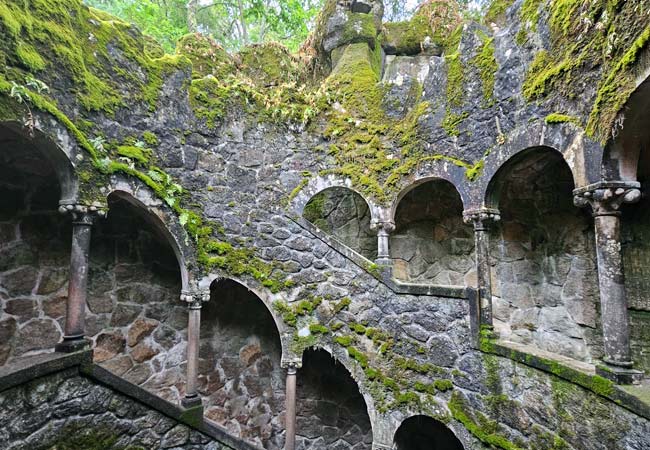
Descending into the Poço Iniciático
Carvalho Monteiro most likely had links to the Freemasons, who practised the rites and rituals of the Knights Templar (and later the Order of Christ). One possible ritual linked to the Poço Iniciático was the initiation of members into the brotherhood. This may have involved the junior member being blindfolded and holding a sword while being led along the caves to the base of the well. From there, they climbed, still blindfolded, up to the top of the well and into the light.
Sadly, today’s visitor route of the Poço Iniciático means that you enter from the top and descend into the gloom of the well.
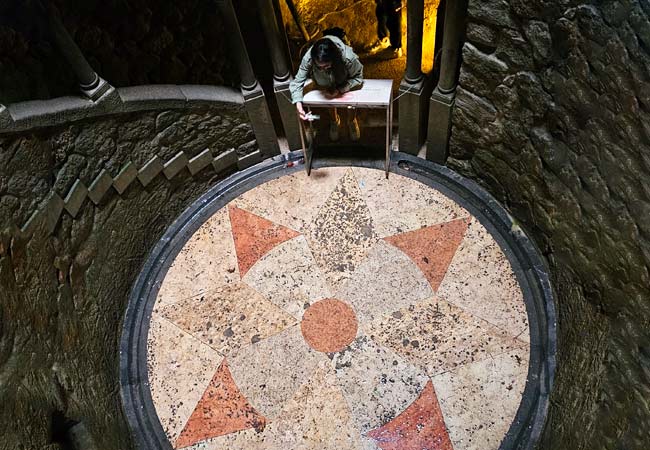
Percursos subterrâneos
The Percursos Subterrâneos is a complex series of subterranean passages carved out of the region's granite bedrock. Some of the passageways are natural caves, but many were dug out during the construction of the Palace.
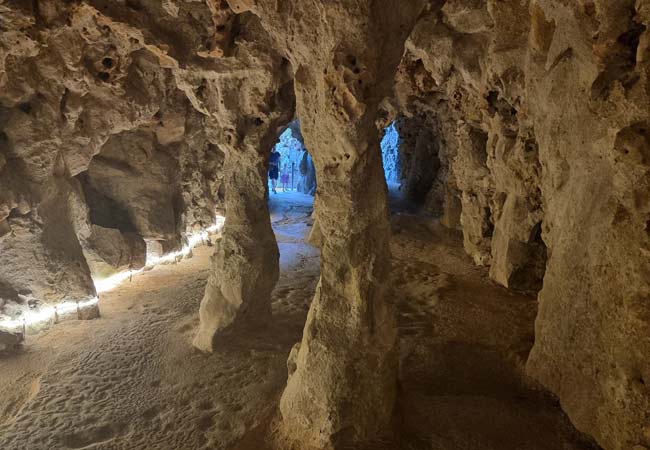
Originally, the caves could be accessed via five entrances: the Gruta do Oriente, the Lago da Cascata, the Portal dos Guardiães, the Iniciático well and the Imperfeito well. For your visit, the only entrance is via the Iniciático well, and the only exit is the Gruta do Oriente. While exploring the caves, make sure to discover the Lago da Cascata, with its stepping stones and entrance concealed behind a waterfall, as well as the Imperfeito well, a partially completed well.
This labyrinth of caves holds many hidden meanings, including themes of darkness and light, and death and rebirth - especially when combined with the possible rituals of the Poço Iniciático.
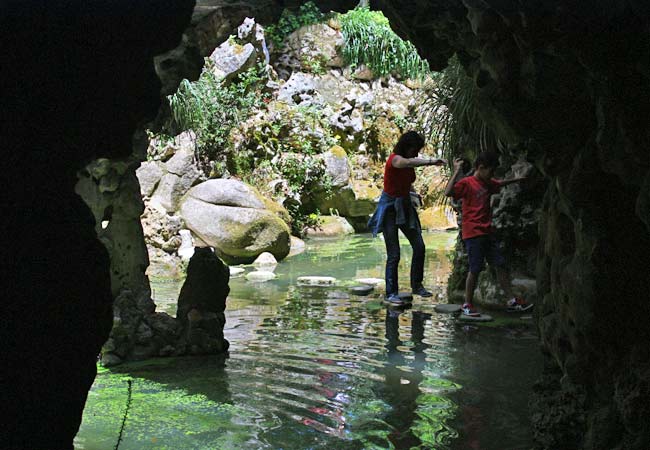
You can no longer enter the Percursos Subterrâneos via the stepping stones of the Lago da Cascata
Portal dos Guardiães
The Portal dos Guardiães (Gate of the Guardians) stands opposite the Terrace of Celestial Worlds. This impressive structure features a tower at either end, linked by a semi-circular walkway - at the centre of which lies a lookout point. The architecture cleverly allows the area to function as an open air theatre, offering both ample space for an audience and favourable acoustics.
Nestled at its base you’ll find a tank and a fountain adorned with guardian figures - two Tritons circling a conch, a nod to mythology where the conch is used to produce calming music.
The structure cleverly disguises the entrances to access tunnels leading to the mid-level of the Poço Iniciático (Initiation Well), the Imperfect Well and the grottos.
The west tower features a staircase leading to the top, while under the other tower lies a shallow tank filled with water.
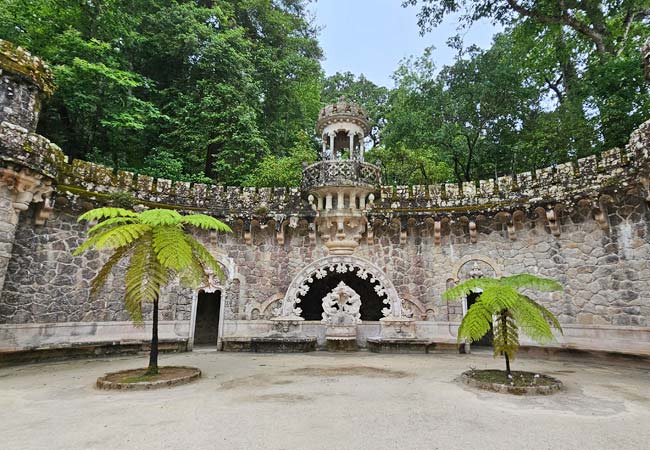
Portal dos Guardiães
History of the Quinta da Regaleira
Enchanting visitors with their charm, today's Quinta da Regaleira Palace and its surrounding gardens owe their existence to Carvalho Monteiro, a wealthy Brazilian businessman. Between 1904 and 1911, Monteiro's tremendous fortune from the coffee and gem trades created the iconic ‘Palace of the Monteiro Millionaire’, or Quinta da Regaleira as we know it. A summary of the complex's historical timeline is:
• 1697: José Leite acquired the lands that would later be transformed into Quinta da Regaleira as a gift for his goddaughter.
• 1715: Francisco Alberto Guimarães de Castro bought the expanse at a public auction and initiated the process of channelling water from the Sintra hills.
• Late 18th century: The property earned the titles of Quinta do Castro and Quinta da Torre.
• 1807: The new owner, João Antonio Lopes Fernandes, embarked on construction - adding a house, a viewpoint, a garden with grottos and a sizeable tank.
• 1830: Manuel Bernardo Lopes Fernandes inherited the lands, renaming them as Quinta da Regaleira.
• 1840: The Baroness of Regaleira, Ermelinda Allen Monteiro de Almeida, took ownership of the Quinta and facilitated numerous enhancements.
• 1893: Antonio Augusto Carvalho Monteiro, the ‘Monteiro of the Millions’, acquired the residence and adjacent plots of land at a public auction.
• 1896-1911: A slew of artists and sculptors collaborated to shape the architectural and landscape designs, leading to the birth of the mansion, stables, chapel and palace.
• 1920: Pedro Augusto de Melo de Carvalho Monteiro inherited the Quinta.
• 1946: Waldemar Jara D'Orey purchased the property.
• 1949-1951: The Regaleira Palace and the Coachman's Mansion underwent decorative modifications under architect Luis de Couto's supervision.
• 1956: Antonio Lino suggested the utilisation of the terrace of the Renaissance House.
• 1975: Maria Helena Ribeiro Cardoso D'Orey became the new custodian of the Quinta.
• 1983: The Quinta was listed for sale again.
• 1988: The Quinta was bought by a Japanese company, Aoki Corporation.
• 1997: The Sintra City Council assumed ownership of the property, converting it into the headquarters of the CulturSintra Foundation, a body dedicated to heritage preservation and cultural activities.
Our most popular guides to Sintra
If you've found our content valuable, we'd welcome your support.
The digital publishing landscape has evolved significantly. As a small independent publisher, we face growing challenges. Search engines increasingly favour paid content over organic results, while AI-generated content often reproduces original work without attribution.
To support our work, please consider bookmarking this page (press Ctrl + D) for quick access. If you find an article helpful, we'd be grateful if you'd share it with friends on social media.
For specific questions, please see our Reddit community at r/LisbonPortugalTravel.
Should you notice any outdated or incorrect information, please contact us at [email protected]
Thank you for helping us continue to provide valuable content in an increasingly challenging digital environment.
A complete list of all of our Sintra and Lisbon guides
If you've found our content valuable, we'd welcome your support.
The digital publishing landscape has evolved significantly. As a small independent publisher, we face growing challenges. Search engines increasingly favour paid content over organic results, while AI-generated content often reproduces original work without attribution.
To support our work, please consider bookmarking this page (press Ctrl + D) for quick access. If you find an article helpful, we'd be grateful if you'd share it with friends on social media.
For specific questions, please see our Reddit community at r/LisbonPortugalTravel.
Should you notice any outdated or incorrect information, please contact us at [email protected]
Thank you for helping us continue to provide valuable content in an increasingly challenging digital environment.





























